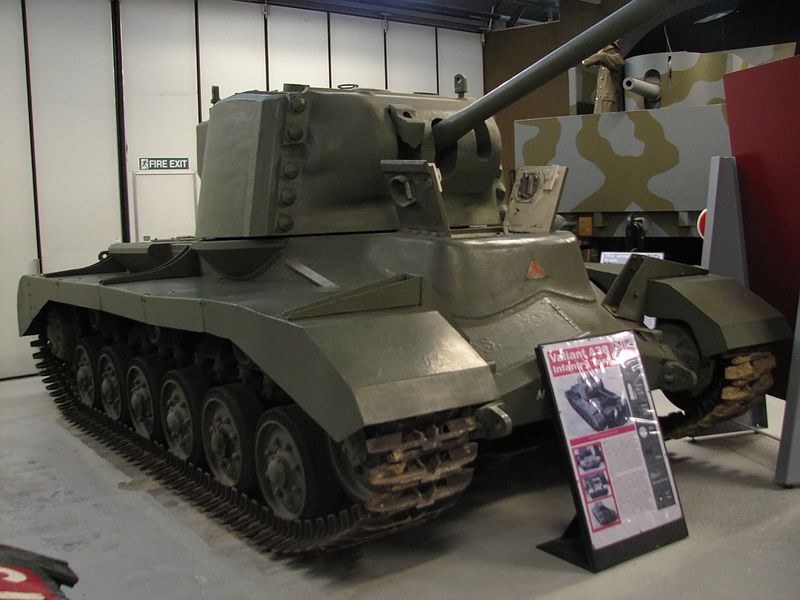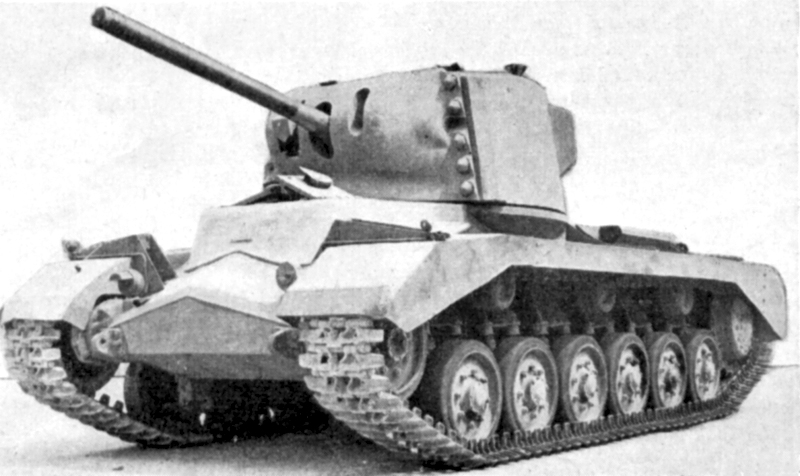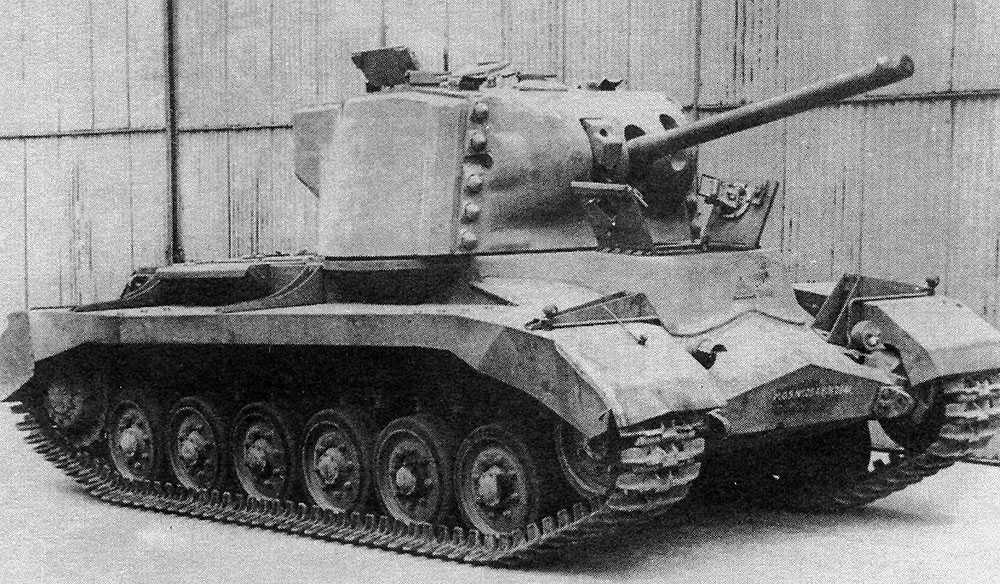A38 Valiant
 Light Infantry Tank Prototype (1943)
Light Infantry Tank Prototype (1943)
United Kingdom - 1 built total
A failed but Valiant Attempt
Securing its place on our shortlist, the A38 gained this title by one of the shortest testing session in history. Indeed the unique prototype (on the three ordered) made its unique test course on a few miles, on a road and in a straight line, before the officer in charge decided to terminate this experience. And it was in may 1945. The war was over in Europe, but not in the Far East, where this tank was expected to fight on. The A38 eventually became after the war a perfect example of how to do it all wrong by the School of Tank Technology. It is now exposed at Bovington.
A two years development
The General Staff specification A38 came out in 1943, asking for an “assault tank”, in fact very much an infantry tank, extremely well protected and designed for the Far East theater of operations. It was a parallel development to the 40-ton A33 Excelsior. At that stage of the war, the other infantry tank Matilda Mark II was obsolete in Europe but soldiered on in the south eastern Asia with Commonwealth troops and proved quite useful there. No serious consideration was given to armament, as the Matilda’s 2-pdr was already adequate against any tank the Japanese could throw at it. The two main points of attention for this design, quite contradictory, were the frontal protection of 114 mm, for an overall weight of no more than 27 tons, same as the first Sherman M4 already in service. But since the latter was a lend-lease product, a domestic design was preferred.
At the beginning Vickers was working on a derivative of the Valentine to share as many components as possible. However since the challenge was tricky at best, the design was passed to Birmingham Railway Carriage & Wagon, then finally Ruston & Hornsby. The latter would eventually produced a boiler plates prototype in 1944, but it would be to the price of many adjustments made to the original design, and at the end, only the powerplant was kept.
Design
The A38 Valiant was made of boiler plates, but in cast sections which were bolted (and not welded) together. Now this created some weaknesses, and the system was repeated with the tall and flat-sided turret. Indeed there was a thick (equally 114 mm) external cast mantlet bolted to the turret. The rest of the armour thickness ranged from 100 mm on the sides to 76 mm on the hull front and 34 mm on the sides and rear. The frontal section was relatively narrow because of the large tracks, and the driver was placed in the center of the tumble-home, with a two-pieces hatch above him and a periscope. The suspension system was a particular one: It consisted not of bogies but of independent wishbone suspension units for each roadwheels, six of them each side, also tailor-made, plus two more used as idlers at the front. The propulsion relies on the same 210 bhp General Motors 6004 two-stroke diesel also used by the Valentine.
Parts and maintenance were to be easier but the engine proved much too feeble for the intended weight, resulting in a top speed of 12 mph (19 km/h) and theoretical off-road speed of 7 mph (11 km/h), which was basically infantry pace, in accordance to the assault tank concept. However for a jungle-type of environment it was not of major concern. The armament relied on a 6-pdr (57 mm) QF gun, completed apparently by a single coaxial 7.92 mm Besa machine gun (not two as stated in Wikipedia). Both were housed in a three-man massive turret (commander, gunner and loader, both having their own hatch side by side). The thickness of the front section prevented the adoption of a supplementary bow machine-gun. The QF 75 mm from the Valentine XI was envisioned also for the turret but never tested.
Causes of rejection
Designs flaws were already apparent in the bolted parts design, the shot-trap effect created by the external mantlet, the feeble engine, the tall three-man turret (obvious target, moreover if the tank was quite slow) and the dubious suspensions (which were never seriously tested). The prototype was completed in late 1944 but apparently led by Fighting Vehicle Proving Establishment at Chertsey only in May 1945. This consisted in a first run on a road, which was abandoned the first day after only 13 miles (21 km).
The reason was that the driver was exhausted, having to force steering levers with all his body weight and therefore the seat, foot brake and gear lever placement were not conceived for such manipulations. Obviously this aspect of the design escaped all previous inquiries and was blatantly overlooked or would have needed post-trials adjustments if the design was sound enough. But the officer in charge noted in his report that “in his view the entire project should be closed”. This was added to an insufficient ground clearance (only 9 inches) and problematic weight distribution despite the relatively large tracks. Overall at that stage of the war it was not worth pursuing it anymore longer.
Sidenote: The Valiant II
Also called “heavy valiant” but little documented (from a February 1944 discussion) was an attempt to place the initial A38 turret on an A33 Excelsior on T1 suspension based chassis, probably shorter, and a revised, superior armour, 9 to 10 in (hull and turret respectively) of thickness (230 to 254 mm) for an overall estimated weight of 42 tons. It was to be propelled by a 400 bhp Rolls Royce Meteorite engine. Although the concept was sound in a cold war context with Soviet tanks armed with 122mm guns, its slow speed related to the concept of infantry tank was no longer relevant after 1945. (David Fletcher’s The Universal Tank, P.Chamberlain & C.Ellis British and American Tanks of World War Two).
Links
The Valiant on wikipeda
The Valiant on Military Factory
Blacktail series about the Valiant
A38 Valiant specifications |
|
| Dimensions | 5.4 x2.8 x2.1 m (17.7 x9.3 x7 ft) |
| Total weight, battle ready | 27 tons |
| Crew | 4 (driver, commander, gunner, loader) |
| Propulsion | GMC 6004 diesel 210 hp (157 kW) 7,8 hp/t |
| Suspension | Individual coil springs, double-wishbone |
| Speed (road) | 19 km/h (12 mph) |
| Range | 80 km (130 miles) |
| Armament | QF 6 pdr (57 mm) gun, coaxial Besa 7.92 mm |
| Armor | 34 to 114 mm (1.3-4.5 in) |
| Total production | 1 in 1944 |
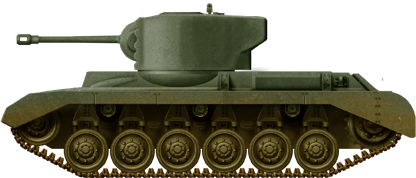
Prototype of the A38 Valiant. Click to see a what-if operational tank.
Gallery
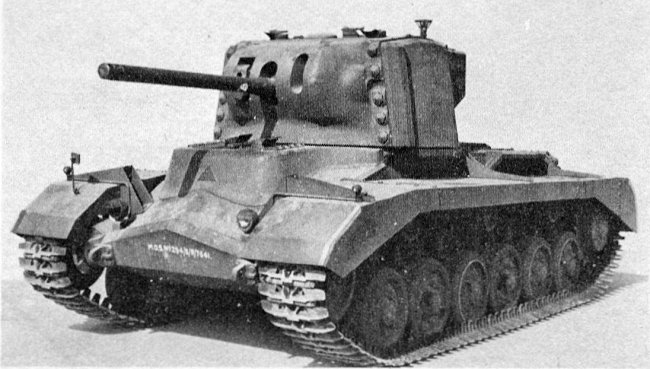
Another front-left view. Notice the 6-pdr without muzzle brake (aviarmor.net)

WW2 Tanks




























WW2 tanks posters

All Tiger tanks liveries.

Panther liveries and variants

WW2 Armour - All tanks











Tanks aces and single tanks series

Find more there

Museums, Movies, Books & Games
The Tanks and Armor in pop culture
Tanks and armored vehicles in general are only really grasped when seen first person: The mass, the scale, it's all there. Explore also the way tanks were covered in the movie industry, in books and in video games.Movies:
Best tanks movie on warhistoryonline.com
On imdb.com
On bestsimilar.com/
miltours.com
liveabout.com/
watchmojo.com
Video Games:
pcgamesn.com
historyhit.com
levvvel.com
vg247.com/best-tank-games
mmobomb.com/
alienwarearena.com

